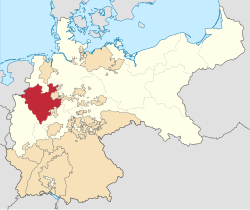Prussian Westphalia
| Province of Westphalia Provinz Westfalen |
||||||
| Province of Prussia | ||||||
|
||||||
|
||||||
|
Anthem Westfalenlied |
||||||
| Westphalia (red), within the Kingdom of Prussia, within the German Empire | ||||||
| Capital |
Münster 51°58′N 7°38′E / 51.967°N 7.633°ECoordinates: 51°58′N 7°38′E / 51.967°N 7.633°E |
|||||
| History | ||||||
| • | Established | 1815 | ||||
| • | Disestablished | 1946 | ||||
| Area | ||||||
| • | 1817 | 20,215 km2(7,805 sq mi) | ||||
| Population | ||||||
| • | 1925 | 4,784,000 | ||||
| Political subdivisions |
Arnsberg Minden Münster |
|||||
The Province of Westphalia (German: Provinz Westfalen) was a province of the Kingdom of Prussia and the Free State of Prussia from 1815 to 1946.
Napoleon Bonaparte founded the Kingdom of Westphalia, which was a client state of the First French Empire from 1807 to 1813. This state shared only the name with the historical region, containing mostly Hessian and Eastphalian regions and only a relatively small part of the region of Westphalia.
Although Prussia had long owned territory in Westphalia, King Frederick William III had preferred to incorporate the Kingdom of Saxony first. It was not until the Congress of Vienna in 1815 that the Province of Westphalia came into being. The province was formed from several territories:
In 1816, the district of Essen was transferred to the Rhine Province.
After the end of World War II, the province was merged with the northern half of the Rhine Province to form the German state of North Rhine-Westphalia in 1946, with the addition of the former state of Lippe in 1947.
The Prussian central government appointed upper presidents as their representatives in the province, supervising the implementation of central prerogatives in Westphalia. Between 1920 and 1933 their appointment needed the consent of the provincial diet, in those years directly elected by the Westphalians.
...
Wikipedia



